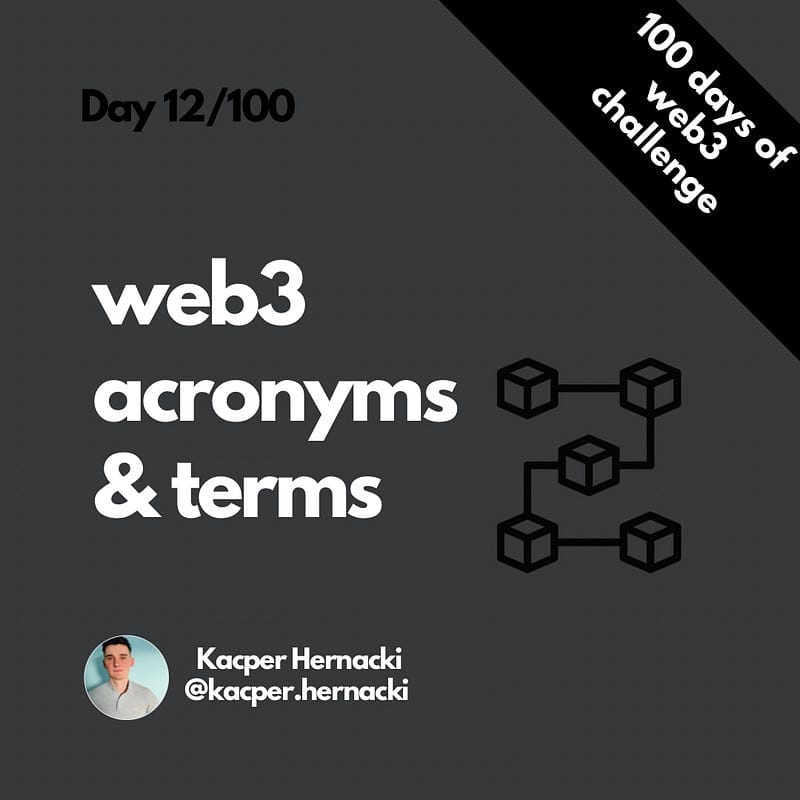Web3 basic acronyms & terms
Everyone who started learning, generally speaking “engineering”, knows that there are a lot of acronyms and terms, which are crucial to…

Everyone who started learning, generally speaking “engineering”, knows that there are a lot of acronyms and terms, which are crucial to learn. There is no exception in web3. Let’s jump straight into it.
ABI
ABI is an acronym for Application Binary Interface, and it is an interface between two binary program modules at the level of machine code, not source code.
Bridge
A bridge is an application that connects two (or more) blockchains. Bridges allows users to send digital assets from one network to another. This also commonly referred to as a “cross-chain” swapping.
Dapp
A Dapp, or decentralized application, is an application built on a decentralized blockchain network using smart contracts and Web 3.0 javascript libraries.
Defi
DeFi is an abbreviation of Decentralized Finance, or an open financial system that doesn’t rely on centralized authorities or intermediaries like banks to conduct financial activities permissionlessly like trading, borrowing, lending, and investing.
EVM
The Ethereum Virtual Machine (EVM) is a software application that blockchain developers use to deploy decentralized applications (Dapp) on the Ethereum blockchain. The EVM interacts with Ethereum’s accounts, smart contracts, and distributed ledger.
Gas
Gas is an unit of measurement that represents the computational effort required to complete a transaction. How much a user spends to complete a transaction is determined by the total amount of gas multiplied by the gas price.
Gas fees
Gas fees are the fees users must pay in Ethereum’s native currency, Ether (ETH), to complete a transaction. Gas fees are used to compensate miners for providing the computational work required to process and validate transactions.
Gas limit
The gas limit is the maximum amount of gas miners are authorized to consume to complete a transaction.
Gas price
The gas price is the amount of Ether (ETH) a user is willing to pay for every unit of gas required to complete a transaction (denominated in Gwei).
Görli
Görli is a cross-client, community-based, proof-of-authority (PoA) Ethereum testnet, where Web3 developers can test smart contracts in a sandbox.
Gwei
Gwei is the smallest denomination of ETH that is equivalent to 1/1,000,000,000 of 1 ETH (1 ETH = 1,000,000,000 Gwei).
Layer one
Layer 1 refers to the main blockchain in a multi-level blockchain network. For example, Ethereum, Fantom and the Bitcoin blockchain are all layer one blockchains.
Layer two
Layer 2 (L2) refers to a secondary framework or protocol that is built on top of an existing, layer one blockchain. Layer 2 blockchains typically improve transaction speeds and cost efficiency.
Mempool
Also known as the “transaction pool,” the “transaction queue,” or “pre-chain,” the mempool is a set of in-memory data structures propagated across Ethereum nodes that store pending transactions before they are mined.
Merkle root
A Merkle root is the single top hash of a Merkle tree. It verifies all transactions within a block.
Merkle tree
A Merkle tree, or hash tree, is a data structure used by blockchains to securely validate and summarize large data sets.
Nonce
Nonce is a number associated with Ethereum transactions that increases by one with every transaction, and a value that can only be used once.
Pending pool
The pending pool is a group of transactions in the mempool that are ready to be processed.
Rinkeby
Rinkeby is a Proof-of-Authority testnet for Ethereum where smart contract developers can test code before deploying it to Ethereum’s mainnet.
Sidechain
A side chain is a blockchain that allows tokens from one blockchain to be securely used within a completely separate blockchain, but still move back to the original chain if necessary.
Smart contract
A smart contract is a piece of code that executes according to it’s instructions exactly like a traditional contract between two people would be executed.
Testnet
A testnet (test network) is where developers can test protocol upgrades and smart contracts before deploying them on mainnet.
Tocenomics
A portmanteau of the words ‘token’ and ‘economics,’ tokenomics refers to all the aspects of a cryptocurrency that can impact the price such as total supply, vesting, and utility.
Wrapped token
Wrapped Ethereum (wETH) is a tokenized version of Ether on the ERC-20 standard. wETH can always be redeemed 1:1 for ETH. It enables functionality with Dapps on Ethereum and other blockchains.




